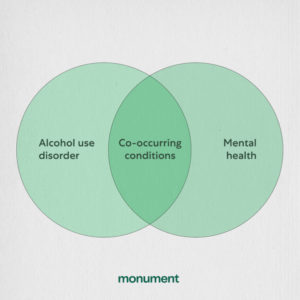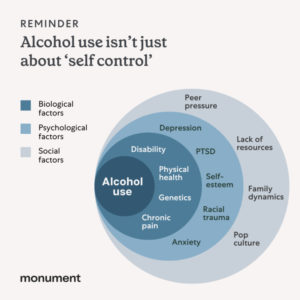What is a Co-Occurring Disorder?
A co-occuring disorder describes the coexistence of a substance use disorder and a mental health disorder.¹ The term ‘co-occurring disorder’ also emphasizes the connection between mental health and substance use. For example, many people experience both alcohol use disorder (AUD) and anxiety. These two conditions affect each other because anxiety can cause someone to drink to cope with anxious thoughts, and conversely, unhealthy alcohol use can cause anxiety levels to rise in the long term.
Mental health conditions and substance use disorders are treatable conditions, and you can find relief from both. The most important thing to remember when navigating a co-occuring disorder is to find a holistic treatment approach that specifically addresses both conditions. Below we will dive into more information about how to identify co-occuring disorders, and how to treat them.
Risk Factors for Co-Occurring Disorders
Why might one individual be more likely to develop co-occurring disorders than another? It’s not by random chance. There are multiple, overlapping risk factors that can contribute to someone’s likelihood of developing mental health and/or substance use disorders.² These may include:
- Biological factors: such as physical health, genetics, chronic pain, and disability
- Psychological factors: such as trauma, self-esteem, and chronic stress
- Environmental factors: such as lack of resources, relationship dynamics, cultural influences, and adverse childhood experiences.
On the biological front, many people are genetically predisposed to mental health and substance use disorders, meaning that they inherited certain genes that make them more likely to develop them. Developing one disorder can even ignite an underlying predisposition to developing another. That said, just because someone has a higher genetic likelihood of having a substance use or mental health disorder, doesn’t mean they necessarily will develop one, or that they can’t live a healthy life. Just like these conditions are intertwined in the way they develop, they can also be treated with similar methods.

How are Co-Occurring Disorders Diagnosed?
Trained clinicians can perform comprehensive assessments to give an accurate diagnosis of co-occurring disorders. There are different assessments specific to each condition. For example, alcohol use disorder is a medical condition diagnosed based on 11 points of criteria per the DSM-5. Mental health conditions, such as anxiety or depressive disorders have similar assessments. A healthcare professional can perform multiple assessments to determine if a co-occuring diagnosis is appropriate.
Diagnoses can change over time, and it can be particularly difficult to disentangle the various overlapping symptoms of mental health conditions and substance use disorders.⁴ Therefore, it can be helpful to also get a professional mental health assessment after a period of abstinence from substances, in order to distinguish between the effects of a substance, and the symptoms of a mental health disorder.⁶
How Common are Co-Occurring Disorders?
Co-occurring disorders are incredibly common. According to the Substance Abuse and Mental Health Services Administration, over 9 million adults in the U.S. have a co-occurring substance use and mental health disorder.¹ The actual number is probably even higher, as many cases go unreported or diagnosed.
The stigma often associated with mental health and substance use disorders does all of us a great disservice and serves as a barrier to treatment for many. These are very common, treatable conditions and there’s no shame in experiencing any combination of them. It’s important to remember that you’re not alone in this, and that most of us are touched in some way by mental health and substance use disorders. We all deserve support and relief, and each hold an amazing capacity to heal.
Types of Co-Occurring Disorders
The most common types of mental health disorders seen in people diagnosed with substance use disorders include:
- Anxiety and Mood Disorders
- Schizophrenia
- Bipolar Disorder
- Major Depressive Disorder
- Post-Traumatic Stress Disorder
- Attention Deficit Hyperactivity Disorder¹
There are many different combinations of co-occurring disorders, and some people may also experience more than two simultaneous conditions. Engaging in a holistic treatment plan can help ensure all aspects of your wellbeing are being addressed.

Treatment Options for Co-Occurring Disorders
There is no one-size-fits-all approach to treatment and recovery, so it’s essential that treatment plans be tailored to meet the specific needs of each person. There are many factors that contribute to finding the right treatment, including a person’s age, the specific substances they use (including the amount and duration of use), their mental health history (including genetic and environmental factors) and a person’s recovery environment. Therapy and medication are two of the most common treatments for co-occurring disorders.
Therapy
Cognitive behavioral therapy, otherwise known as CBT, helps an individual gain a greater understanding of and control over their thoughts and behavior. Because of this, it’s commonly used to help those managing a substance use disorder, a mental health condition, or both. Therapy can also help someone navigating co-occurring conditions with the following:
- Regulating emotions
- Restructuring negative thought patterns
- Building healthy coping skills
- Processing past experiences
For anyone looking to change their relationship with alcohol, specialized alcohol therapy can help you cut back on drinking while navigating co-occurring conditions like depression and anxiety. You can meet with a therapist specialized in CBT, who will work with you to create a personalized treatment plan that addresses your specific needs and goals.
Medication
Medication-assisted treatment can also be very helpful for many people. There are various FDA-approved medications to help you stop drinking that work to curb alcohol cravings. There are also medications used to treat opioid and nicotine use.⁴ Also, there are a number of medications, like SSRIs, that can help someone manage a mental health condition like depression or anxiety. Using medication does not make your recovery any less valid – in fact, medication can provide you with more mental energy and clarity to focus on your healing and progress.
Learning more about co-occurring disorders can be an empowering process in itself. Having a support network can also make a huge difference. You can join the Monument community and get support online and anonymously. Whatever your next step, remember that you are not alone.
Sources:
- Substance Use and Mental Health Services Administration. “Co-occurring Disorders and Other Health Conditions.,” https://www.samhsa.gov/medication-assisted-treatment/medications-counseling-related-conditions/co-occurring-disorders. Accessed Sep. 9, 2022.
- National Institute on Drug Abuse. “Why is There Comorbidity Between Substance Use Disorders and Mental Illnesses?,”
https://nida.nih.gov/publications/research-reports/common-comorbidities-substance-use-disorders/why-there-comorbidity-between-substance-use-disorders-mental-illnesses. Accessed Sep. 9, 2022. - Substance Use and Mental Health Services Administration. (n.d.). “Risk and Protective Factors, https://www.samhsa.gov/sites/default/files/20190718-samhsa-risk-protective-factors.pdf.” Accessed Sep. 9, 2022.
- National Institute of Mental Health. “Substance Use and Co-occurring Mental Health Disorders, https://www.nimh.nih.gov/health/topics/substance-use-and-mental-health.” Accessed Sep. 9, 2022.
- National Institute on Drug Abuse. “Common Comorbidities with SUD Research Reports: What are Some Approaches to Diagnosis?, https://nida.nih.gov/publications/research-reports/common-comorbidities-substance-use-disorders/what-are-some-approaches-to-diagnosis.” Accessed Sep. 9, 2022.
- Centers for Disease Control. (June 28, 2021). About Mental Health, https://www.cdc.gov/mentalhealth/learn/index.htm.” Accessed Sep. 9, 2022.
- Substance Use and Mental Health Services Administration. “Trends in Substance Use Disorders Among Adults Aged 18 or Older.,” https://www.samhsa.gov/data/sites/default/files/report_2790/ShortReport-2790.html. Accessed Sep. 9, 2022.
